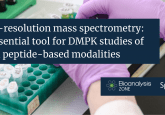 Bertrand Rochat: “Many labs perform quantitative analyses with QQQ–MS under international certified rules. This means that, in general, there is a rather high degree of conservatism. Thus, it is not obvious that these labs will change their mind in favor of HRMS. Moreover, for some of these labs, the replacement of QQQ–MS by HRMS is really not useful: targeted HRMS acquisitions (SIM, PRM) are not better than SRMs on QQQ–MS. But for many other labs, the use of HRMS (performing HR-full scan) instead of QQQ–MS (performing ion transitions) can be truly useful because, on the top of targeted quantitative analysis (that can be performed on both QQQ and HRMS instruments), HRMS can bring additional, useful and unexpected information. Therefore, I believe that national authorities should understand the capabilities of HRMS (e.g. global acquisition and retrospective data treatment) and truly promote HRMS in certified analyses.”
Bertrand Rochat: “Many labs perform quantitative analyses with QQQ–MS under international certified rules. This means that, in general, there is a rather high degree of conservatism. Thus, it is not obvious that these labs will change their mind in favor of HRMS. Moreover, for some of these labs, the replacement of QQQ–MS by HRMS is really not useful: targeted HRMS acquisitions (SIM, PRM) are not better than SRMs on QQQ–MS. But for many other labs, the use of HRMS (performing HR-full scan) instead of QQQ–MS (performing ion transitions) can be truly useful because, on the top of targeted quantitative analysis (that can be performed on both QQQ and HRMS instruments), HRMS can bring additional, useful and unexpected information. Therefore, I believe that national authorities should understand the capabilities of HRMS (e.g. global acquisition and retrospective data treatment) and truly promote HRMS in certified analyses.”
 Diego Cortes: “In the case of HRMS, the ability to perform both qualitative and quantitative analysis is very appealing. From a drug discovery pIn general, the current guidance on validating a bioanalytical method appears to be sufficient and additional guidelines may not be needed; regulatory guidelines are not specific with respect to the type of LC–MS platform used. There are several published, small molecule HRMS-based quantitative assays considered fully validated and compliant with current guidelines. However, the bioanalytical community still needs to come together regarding specific recommendations for HRMS-specific approaches and certain parameters, such as the use of mass extraction windows, and how to best apply them in validated methods applied to regulated studies. This could be achieved through White Papers, based on best practices developed within pharmaceutical companies and CROs.”
Diego Cortes: “In the case of HRMS, the ability to perform both qualitative and quantitative analysis is very appealing. From a drug discovery pIn general, the current guidance on validating a bioanalytical method appears to be sufficient and additional guidelines may not be needed; regulatory guidelines are not specific with respect to the type of LC–MS platform used. There are several published, small molecule HRMS-based quantitative assays considered fully validated and compliant with current guidelines. However, the bioanalytical community still needs to come together regarding specific recommendations for HRMS-specific approaches and certain parameters, such as the use of mass extraction windows, and how to best apply them in validated methods applied to regulated studies. This could be achieved through White Papers, based on best practices developed within pharmaceutical companies and CROs.”
 Graeme Clark: “Regulatory agencies do not preclude the use of HRMS in quantitative environments and if the technology was required to offer the necessary level of selectivity, (and backed up with scientific rationale), I do not believe there would be any resistance. What would be useful is an understanding from these bodies of how many, if any, submissions have been made to them using the technique. There will always be a reluctance to adopt a technology if companies feel the regulatory agency will push back on its use and as such a concern over ‘who’s going to jump first?’ will always exist.”
Graeme Clark: “Regulatory agencies do not preclude the use of HRMS in quantitative environments and if the technology was required to offer the necessary level of selectivity, (and backed up with scientific rationale), I do not believe there would be any resistance. What would be useful is an understanding from these bodies of how many, if any, submissions have been made to them using the technique. There will always be a reluctance to adopt a technology if companies feel the regulatory agency will push back on its use and as such a concern over ‘who’s going to jump first?’ will always exist.”
 Ian Edwards: “Guidance from regulatory agencies is geared toward established chromatographic methods (small molecule) and ligand binding assays (large molecule), but they also have the scope to cover LC–MS. This leaves the sponsor to work within the constraints of the guidelines, which state clearly that for data supporting regulatory submissions, the method should be fully validated according to the validation acceptance criteria. For protein quantification by LC–MS/MS using the surrogate peptide approach, consensus recommendations from the bioanalytical industry exist to guide analysts in developing a validated assay. For emerging techniques such as intact protein quantification, dialogue, and recommendations from industry panels will be required to help guide how to approach the development of assays including data processing standards.”
Ian Edwards: “Guidance from regulatory agencies is geared toward established chromatographic methods (small molecule) and ligand binding assays (large molecule), but they also have the scope to cover LC–MS. This leaves the sponsor to work within the constraints of the guidelines, which state clearly that for data supporting regulatory submissions, the method should be fully validated according to the validation acceptance criteria. For protein quantification by LC–MS/MS using the surrogate peptide approach, consensus recommendations from the bioanalytical industry exist to guide analysts in developing a validated assay. For emerging techniques such as intact protein quantification, dialogue, and recommendations from industry panels will be required to help guide how to approach the development of assays including data processing standards.”
 Scott Summerfield: “Regulators base their opinions on the filings that come across their desks. If we, as an industry present a good scientific rationale for the selection of HRMS and show a convincing package of method and system validation then the regulators will accept the case.”
Scott Summerfield: “Regulators base their opinions on the filings that come across their desks. If we, as an industry present a good scientific rationale for the selection of HRMS and show a convincing package of method and system validation then the regulators will accept the case.”
 Timothy Garrett: “I’m not an expert in this, but I do see a gap in how we deal with quality control of multiple metabolites in a single run compared to a single analyte.”
Timothy Garrett: “I’m not an expert in this, but I do see a gap in how we deal with quality control of multiple metabolites in a single run compared to a single analyte.”
< 3 4 5 >
Back to Ask the Experts: HRMS

Bertrand Rochat: “Many labs perform quantitative analyses with QQQ–MS under international certified rules. This means that, in general, there is a rather high degree of conservatism. Thus, it is not obvious that these labs will change their mind in favor of HRMS. Moreover, for some of these labs, the replacement of QQQ–MS by HRMS is really not useful: targeted HRMS acquisitions (SIM, PRM) are not better than SRMs on QQQ–MS. But for many other labs, the use of HRMS (performing HR-full scan) instead of QQQ–MS (performing ion transitions) can be truly useful because, on the top of targeted quantitative analysis (that can be performed on both QQQ and HRMS instruments), HRMS can bring additional, useful and unexpected information. Therefore, I believe that national authorities should understand the capabilities of HRMS (e.g. global acquisition and retrospective data treatment) and truly promote HRMS in certified analyses.”
Diego Cortes: “In the case of HRMS, the ability to perform both qualitative and quantitative analysis is very appealing. From a drug discovery pIn general, the current guidance on validating a bioanalytical method appears to be sufficient and additional guidelines may not be needed; regulatory guidelines are not specific with respect to the type of LC–MS platform used. There are several published, small molecule HRMS-based quantitative assays considered fully validated and compliant with current guidelines. However, the bioanalytical community still needs to come together regarding specific recommendations for HRMS-specific approaches and certain parameters, such as the use of mass extraction windows, and how to best apply them in validated methods applied to regulated studies. This could be achieved through White Papers, based on best practices developed within pharmaceutical companies and CROs.”
Graeme Clark: “Regulatory agencies do not preclude the use of HRMS in quantitative environments and if the technology was required to offer the necessary level of selectivity, (and backed up with scientific rationale), I do not believe there would be any resistance. What would be useful is an understanding from these bodies of how many, if any, submissions have been made to them using the technique. There will always be a reluctance to adopt a technology if companies feel the regulatory agency will push back on its use and as such a concern over ‘who’s going to jump first?’ will always exist.”
Ian Edwards: “Guidance from regulatory agencies is geared toward established chromatographic methods (small molecule) and ligand binding assays (large molecule), but they also have the scope to cover LC–MS. This leaves the sponsor to work within the constraints of the guidelines, which state clearly that for data supporting regulatory submissions, the method should be fully validated according to the validation acceptance criteria. For protein quantification by LC–MS/MS using the surrogate peptide approach, consensus recommendations from the bioanalytical industry exist to guide analysts in developing a validated assay. For emerging techniques such as intact protein quantification, dialogue, and recommendations from industry panels will be required to help guide how to approach the development of assays including data processing standards.”
Scott Summerfield: “Regulators base their opinions on the filings that come across their desks. If we, as an industry present a good scientific rationale for the selection of HRMS and show a convincing package of method and system validation then the regulators will accept the case.”
Timothy Garrett: “I’m not an expert in this, but I do see a gap in how we deal with quality control of multiple metabolites in a single run compared to a single analyte.”




